Growing gourds for birdhouses, in containers, and for-profit use to not to be a popular crop to grow at home. But recently over the last few years, it has gained popularity amongst the homesteader. Growing gourds for profit can make a good money crop too. Most people grow gourds only for ornamental purposes such as birdhouses.
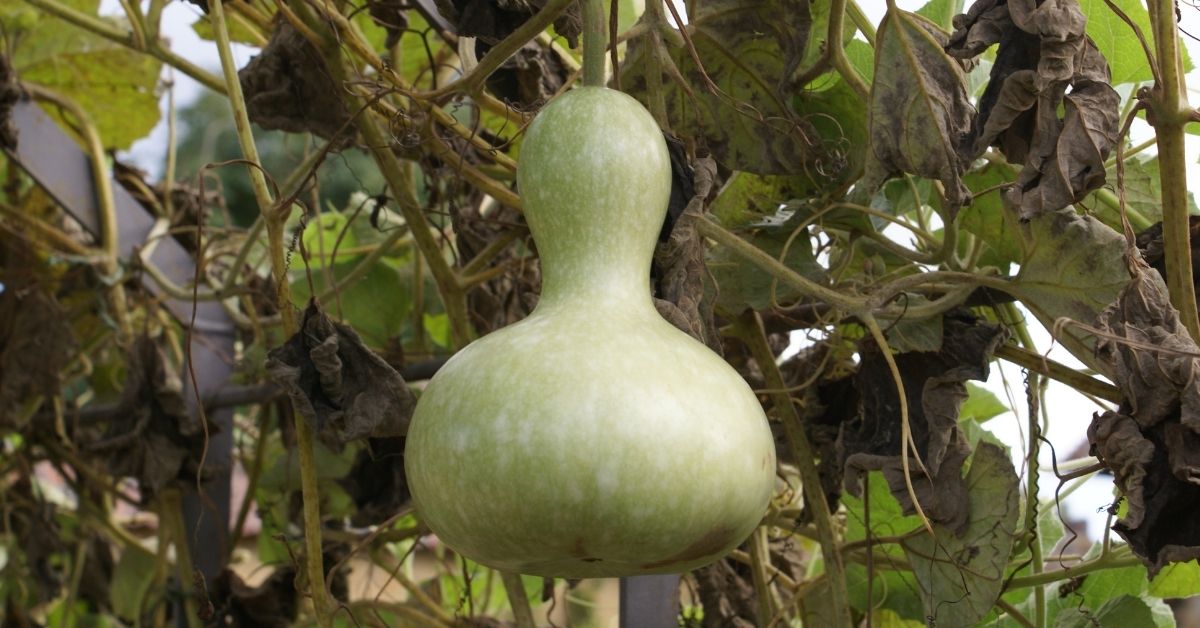
Some gourds are grown for crafts such as bowls, loofah for making soap, cleaning, and so on. Even city dwellers can plant a gourd in a container and have fun too! If you are a beginning gardener, check out my blog Gardening Tips For Beginners, it may provide additional information that is not covered here.
All varieties of gourds are a vine plant with large foliage and beautiful white or yellow flowers which later become gourds of various shapes. The plant spreads fast and can be a real issue if it does not have proper support in place.
Over the years, people have invented various new methods to grow gourds even in limited spaces using containers. I now use the container method to grow gourds since I live on a mountain ridge with very little ground space. I have a blog, Vertical Gardens for Small Spaces that will tell and show you how to grow anything in the vertical position.
Table of Contents or Collapse to Hide
Gourd Planter Containers
Ditch the plastic and grow then use your very own gourd planter container! At the end of the season, if you choose not to reuse it again, the whole pot can go right in the compost and worm bin. Remember to save the seeds for next year. Finish reading the blog post below for more tips and tricks.
Growing Gourds Video Tutorial
Growing Gourds in Containers
Gourds are a versatile plant. It can be planted both in the ground or in containers. However, before planting gourds, it is important that you already have a plan for their growth.
Unless you have a really large space, it is important to provide a sturdy trellis because gourds will sprawl everywhere. The trellis helps them grow under control, keep the fruit clean, and also require less garden space.
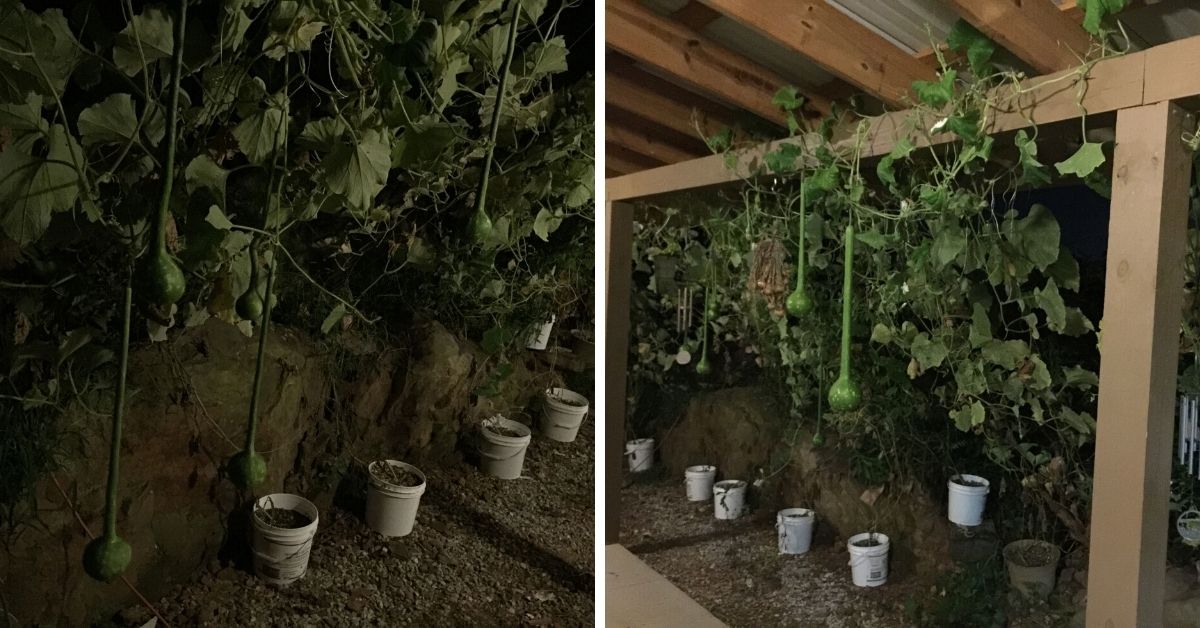
Growing gourds in containers are also possible but expect fewer fruits compared to the one planted in the open garden. You will also need to prepare a trellis frame or you can also use a fence. Do you like container gardening and want to know how to? Check out my blog Guide to Container Gardening to learn!
Growing Conditions for Gourds
General requirements for growing gourds in containers
- Soil – growing gourds is very easy. It can be planted in any type of soil as long as you amend the soil and use fertilizers.
- Weather – gourds are not the plant to grow in the short season. In a warmer region, such as tropical or subtropical areas, gourds grow all year round and no offseason. In summer, gourds only need excess watering. Meanwhile, in colder regions, gourds can be planted as an annual crop. You start planting gourds in spring and grow them until autumn. In general, gourds require plenty of sunlight, regular watering, and moderately fertile soil.
- Watering – Gourds love water, so you need to regularly water it directly on the roots. When gourds get enough water, they can produce bigger flowers and leaves. Also, if the gourds are trained over wires or frames, it is important to keep the roots moist all the time.
- We grow ours in buckets, supported by wire and the water from the roof overhang tends to water them for us, leaving very little we have to do besides give them fish emulsion periodically.
Growing Gourds for Profit
Growing gourds for commercial purposes requires a large garden. You can plant the gourd 3 to 4 feet apart, but if you put wires or frames, then plant the gourds 1.5 to 2 feet apart. Even though you can grow gourds for commercial, it is better to grow it vertically because you can have more plants.
Also, growing gourds vertically makes the plant produce beautifully shaped and clean gourds. In the early stages, you will need a bamboo frame to support the young plant. Avoid getting a kink in the stems. Or try the wires that we use.
Different Types of Gourds
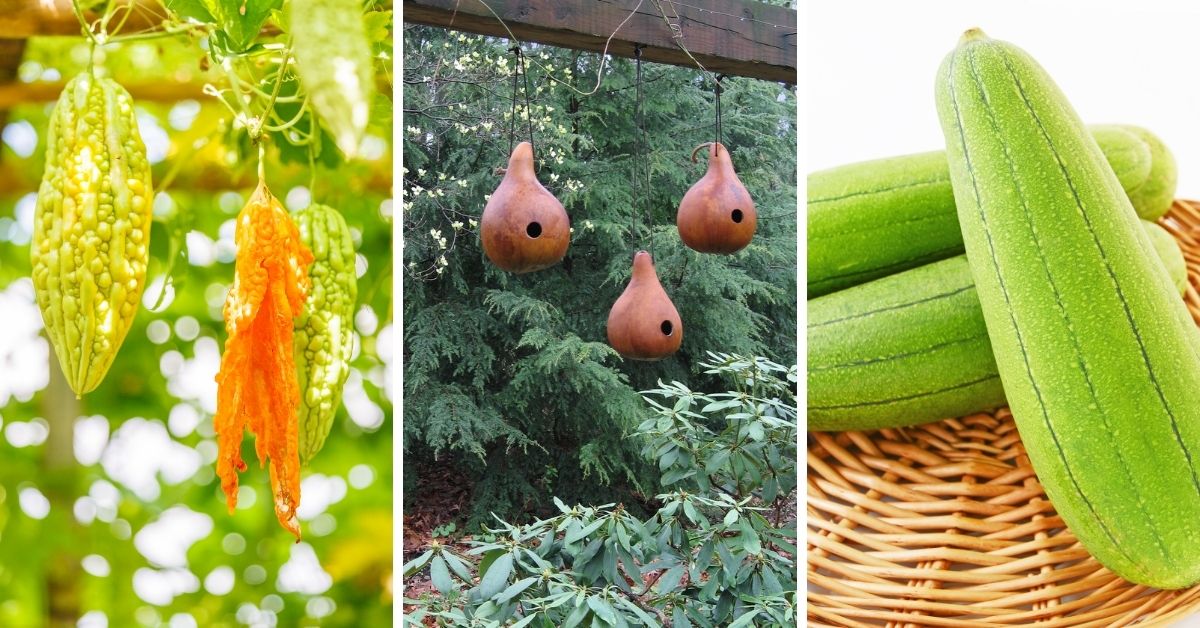
There are numerous types of gourds that you can plant. Different gourds may have slightly different care but in general, gourds are the type of plant that is easy to grow and spread. Here are some types of gourds that you can grow at home.
- Bottle gourd – This gourd is also known as long melon and considered the most productive variety. In its natural space, bottle gourd requires lots of space but you can also grow it in the container but expect the plant to produce fewer fruits.
- Bitter gourd – the bitter taste makes this gourd different from other plants. The bitter gourd vine can reach up to 10-meter height with lush green leaves and beautiful yellow flowers.
- Sponge gourd – (AKA Loofah) (seen above in the picture). There are two varieties of sponge gourds that are smooth loofah which has a smooth texture and smaller fruits and the other is Ridged loofah that has bigger fruit. This is what we use in our soaps to have a scrubber and soap combined in one bar. My friend Stephanie has a post, How to Grow a Loofah Sponge that is packed with useful and fun information.
- Apple gourd – The apple gourd has an apple-like shape. This gourd is also known as Indian round gourd and widely cultivated in some parts of South Asia countries.
- Snake gourd – The snake gourds are best planted with frame or wide because it keeps the fruit long and beautiful. This type of gourd is edible but should be picked when tender and immature.
How Many Gourds Can be Produced in one Plant?
Normally one plant can grow 3-4 gourds, but it can be less productive if you plant more than one gourd in a container. For the best results, you can plant one gourd in one container. If planting in the ground, make sure to provide wide space so it can develop and produce lots of fruit.
We plant 2 plants in one container and weed out the weaker one once the other plant is strong. We cut the plant with snips, do not pull on it since it may be intertwined in the other plant.
What is the Best Fertilizer for Gourds?
Gourds love to feed on fertilizer. They are heavy feeders. They require quite a large amount of compost and manure when planting the seeds or plants. I recently did a whole video on how to make your own Manure Tea Fertilizer, which is all-natural.
Especially, if growing gourds in containers, it is best to feed gourds manure tea a little each week. I also alternate with fish emulsion. Would you like more information on the fish emulsion? Check out my blog post, Fish Emulsion Fertilizer, How to Make and Use!
Growing Gourds on Fences
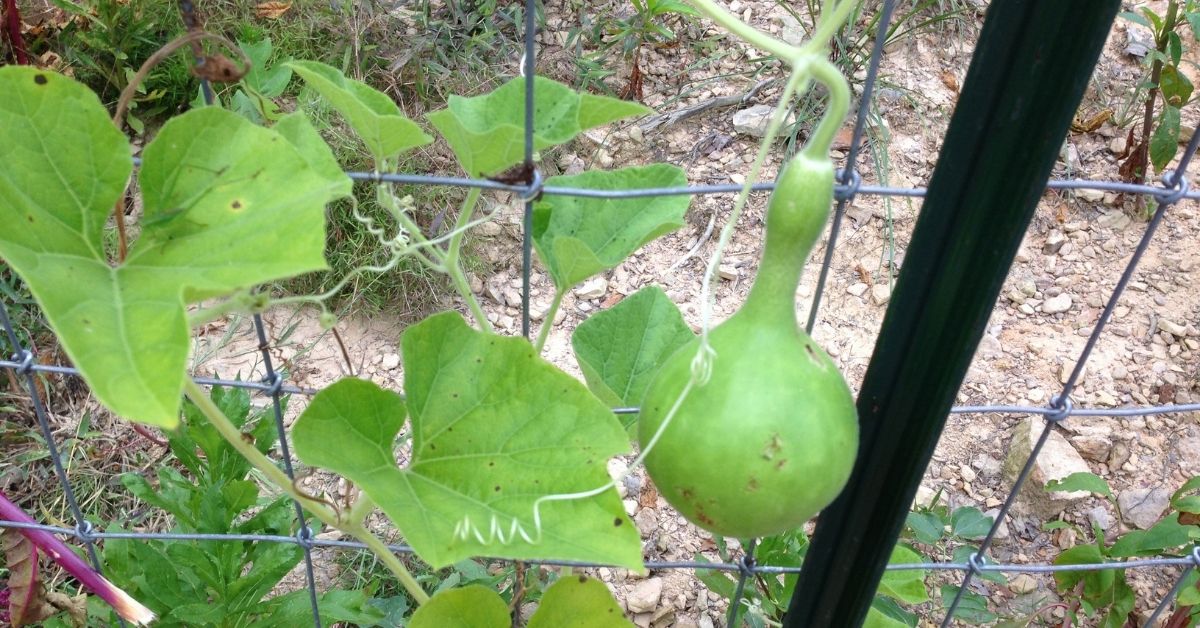
Growing gourds on fences are one of the best methods that you can try. The fence helps the gourds to grow vertically and makes the fruit clean and better in shape.
To grow gourds on the fence, you will need extra space under the fence. Even though growing gourds on the fence is fun, you will need to regularly trim the plant, otherwise, it will fully grow all over the fence.
How Long Does it Take to Grow Gourds?
Gourd seeds usually will germinate after 8-10 days and start to grow independently at 4 weeks. After 10 weeks, the gourd vines begin to produce flowers and set fruits. Gourds can be harvested depends on your needs.
If you are going to consume the gourd, you need to harvest it before it gets ripe. But for crafting and other purposes, you can harvest it once the gourds vine looks dry. Leave the fruit on the vine to completely dry. We leave our gourds on the vine until the first frost, then we harvest them.
Starting Gourds Seed Indoors
Gourds’ root systems are fragile, so to speak. If you are going to start gourd seeds indoors, it is best to put 2 seeds in one container. Start the seeds at least one month before the last spring frost in your area.
I remove the weakest plant once the vine starts to grow to ensure I left the best one. An average of 60-75% of seeds will germinate. That is why I always plant at least 2-3 in the same container.
NOTE: gourd seeds are slow to germinate, have patience.
Soaking Gourd Seeds Before Planting
Like many seeds, gourds do have a hard seed coat. If I direct plant the seeds, especially in containers, I will always soak the seeds in filtered water for at least one day. This can be done too when starting the seeds indoors as well in pots.
You can also scarify the seeds. This means to cut a little notch in the seed. I have done this in the past but admit, it’s just as easy to let them soak overnight. You may also wrap the soaked seeds in paper towels and place them in a container with a lid in a warm place before planting to give them an extra start before planting in soil.
When to Pick Gourds for Harvesting
You may pick gourds when the outer shell is very hard. If you cannot push your fingernail in the fruit that leaves an indent, then it is ready. I always leave mine on the vine to dry. No matter when you pick the gourd, always leave a little amount of vine attached for extra insurance.
How Long Does it Take to Dry Gourds?
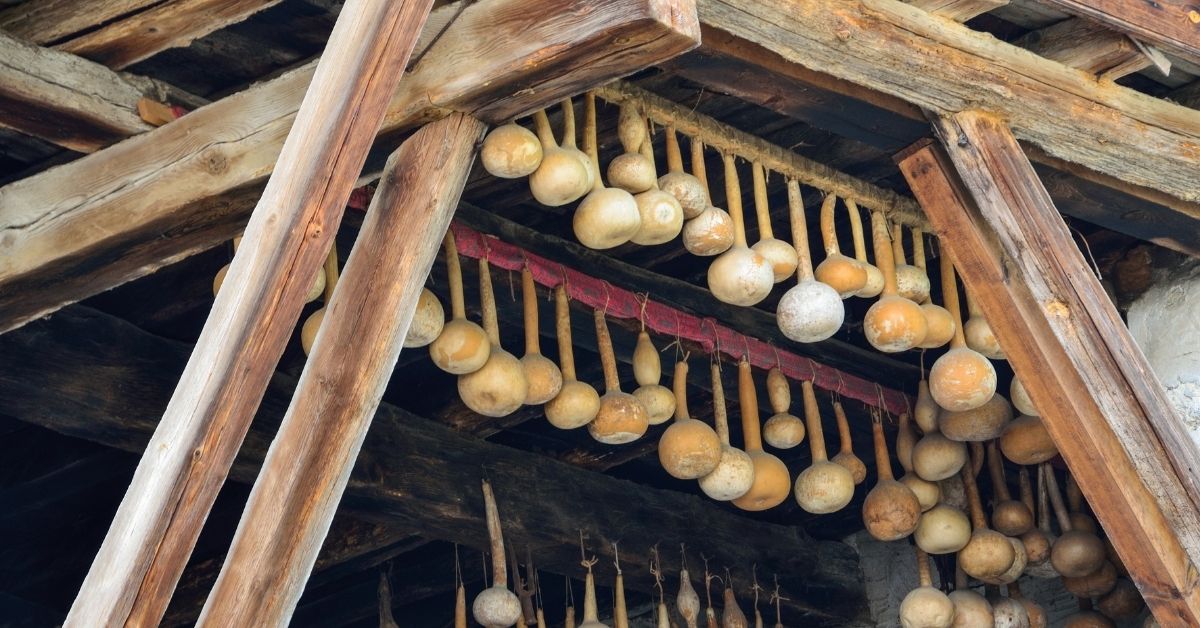
Drying gourds can be different depends on the weather. However, in general, it takes around 5 weeks for gourds to completely dry. Some people simply place the gourd in rows, which is called windrows, and regularly turn it over, so it completely dries out. The dry gourds then can be used for various purposes such as decoration and crafts.
The best temperature for gourd drying is around 50-60 degrees. The cooler the better to slow down the molding process. It’s best to keep the area cool and not a warm place. Attics, garage, or dry basements.
It could take as long as 4-6 months, even longer for the gourds to completely dry. Don’t let them touch each other. You can tie a piece of jute around the next to suspend them from the ceiling to dry better.
How to Wash Gourds
Once the gourds have dried, preferably, on the vine. Remove the gourd and allow it to dry further. Once the gourd is dry (when the seeds rattle inside), then I will wash the gourds.
- Fill a basin with warm water
- Swish FBC veggie soap in the water for a few seconds
- Add a few tablespoons of bleach to the water
- Let soak for at least 15 minutes up to an hour
- Scrub well
- Rinse well
Once the gourd is washed and rinsed well. I lightly spray the surface with rubbing alcohol as a disinfectant. Allow this to dry. Hang and keep dry until ready to use.
How to Dry the Gourd Seeds for Planting Next Year?
Gourd mold dust can be very harmful. Be mindful and wear a respirator or even a dust mask will help. Always wear protection when sanding, cutting, and burning the gourd. Gloves are best too. No telling what moldy water could do if you have an open cut. It is better to err on the side of caution with this project.
- Ensure the gourd is well dried inside and out
- Cut a hole either with a saw or a hacksaw
- Pull out all the innards
- Separate the seeds from the other dried pulp pieces
- Leave the seeds on paper to dry for a day to too in the open air
- Wrap the seeds in a DRY paper towel
- Seal in a manilla envelope
- Date
- Keep in a dry location out of bugs and mice’ reach
Once you buy your gourd seeds, you will never have to buy more! Gourd seeds produce gourds that produce more seeds for you to use the following year, so drying them out will benefit you and help you with growing them for free the next year!
Keep all the innards and add them to the compost bin? Need more compost information? My blog Making Compost Naturally into Garden Soil tells you how I never let anything go to waste!
Save those discarded stems for other crafts. They go for a pretty penny on eBay. I use mine for the primitive dolls I make.
How to Seal Gourds
To seal the inside of gourds, only use an acrylic base finish. Don’t use any oil-based finishes. Sealing the inside will definitely cut down on the dust that comes once the gourd is cut open and cleaned.
To seal the outside of the gourd for a natural look, apply a polyurethane, satin, or high gloss. I prefer the matte finish myself. You can also paint the gourd.
My blog post Problems and Making Money From Homesteading is a very informational and interesting post, so be sure you check it out!
Gourds for Crafts
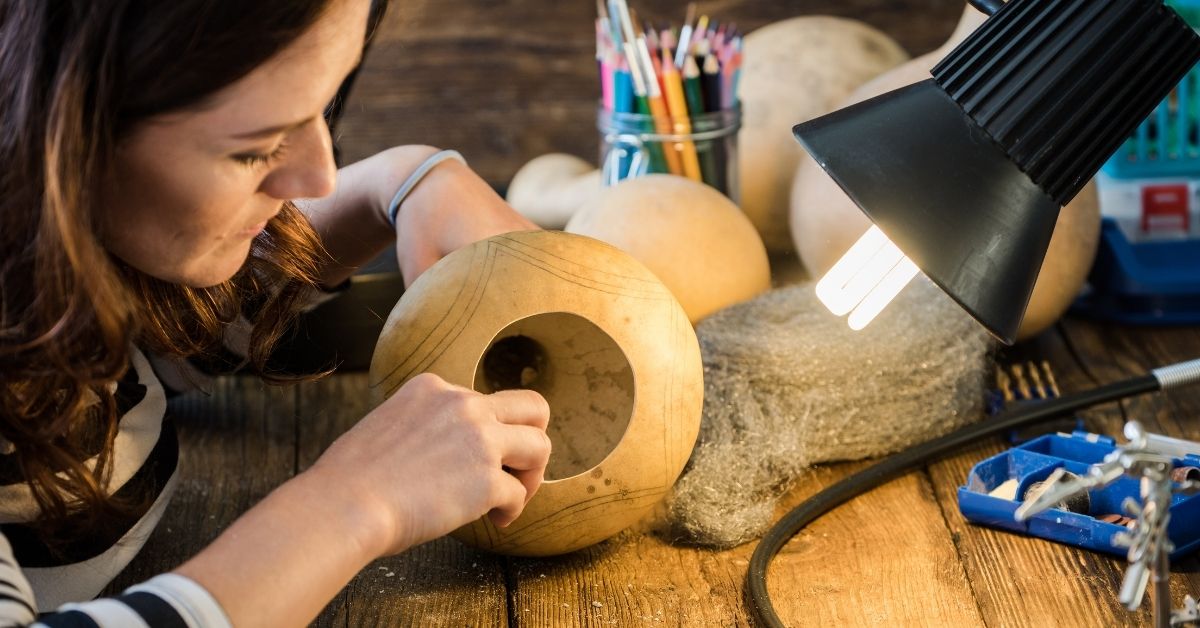
Many people grow gourds because they can do some crafts out of them such as birdhouses. Bottle gourd is the best gourd variety for birdhouses because it has harder skin.
Gourds for Candle Holders
Safety first! Before beginning to use any gourds for candles, please make sure the bottom is very flat to hold the candles.
The drill paddle bit for tea light candles is 1-1/2 inches wide. Drill down approximately 1/2 of an inch to hold the tea light snuggly. Pop in a tea light, it is best to use the tea light holder that usually comes with the light.
For tapered candles, use a 3/4″ paddle drill bit. This seems to work well and holds the candle in the gourd snuggly. Drill a hole at least 3/4″ inch deep, a half-inch would work too. Since these gourds will not be able to be cleaned out, use the candle gourd immediately as the innards will start to rot. This is a good idea right before preparing a meal and having guests.
For making your own gourd votive candle, drill out most of the gourd, remove the innards and pour hot melted beeswax in the hole. Don’t forget to add a wick. Crackling wicks are all the rage right now and I personally love them!
Conclusion for Growing Gourds
Gourds are very versatile and can last a very long time. They are inexpensive to grow yourself and the creative possibilities are endless!
Home Guide has provided an article, Fact About Gourds so you can know everything about them! What is your favorite fact about these lovely plants?
Check out Rare Seeds, they have an awesome selection of gourds seeds!
Shop Here:
We are a participant with the Amazon Services LLC Associates Program, an affiliate advertising program designed to provide a means for us to earn fees by linking to Amazon.com and affiliated sites.
You will not incur extra fees or charges for using the links. We only recommend items we believe in and have tried. If I personally make or sell an item, I will mention this in the post for each item or items.
Farmhouse BC Veggie Soap can be found on Amazon
Luffa Gourd Seeds can be found on Amazon
Birdhouse Bottle Gourd Seeds can be found on Amazon
Tea Light Candles Made In The USA can be found on Amazon
Beeswax can be found on Amazon
Wood Candle Wicks can be found on Amazon
Gardening Tool Set can be found on Amazon
Gardening Gloves can be found on Amazon
pH Tester can be found on Amazon
DE can be found on Amazon
Compost Tumbler can be found on Amazon
Large 5 Tier Vertical Garden Tower can be found on Amazon
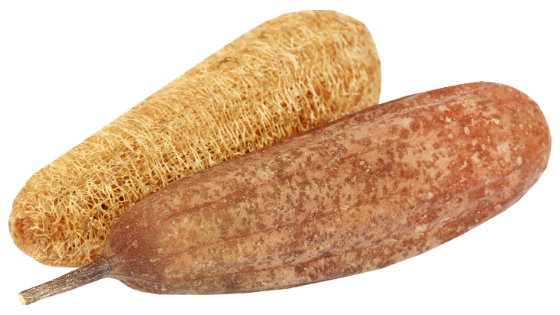


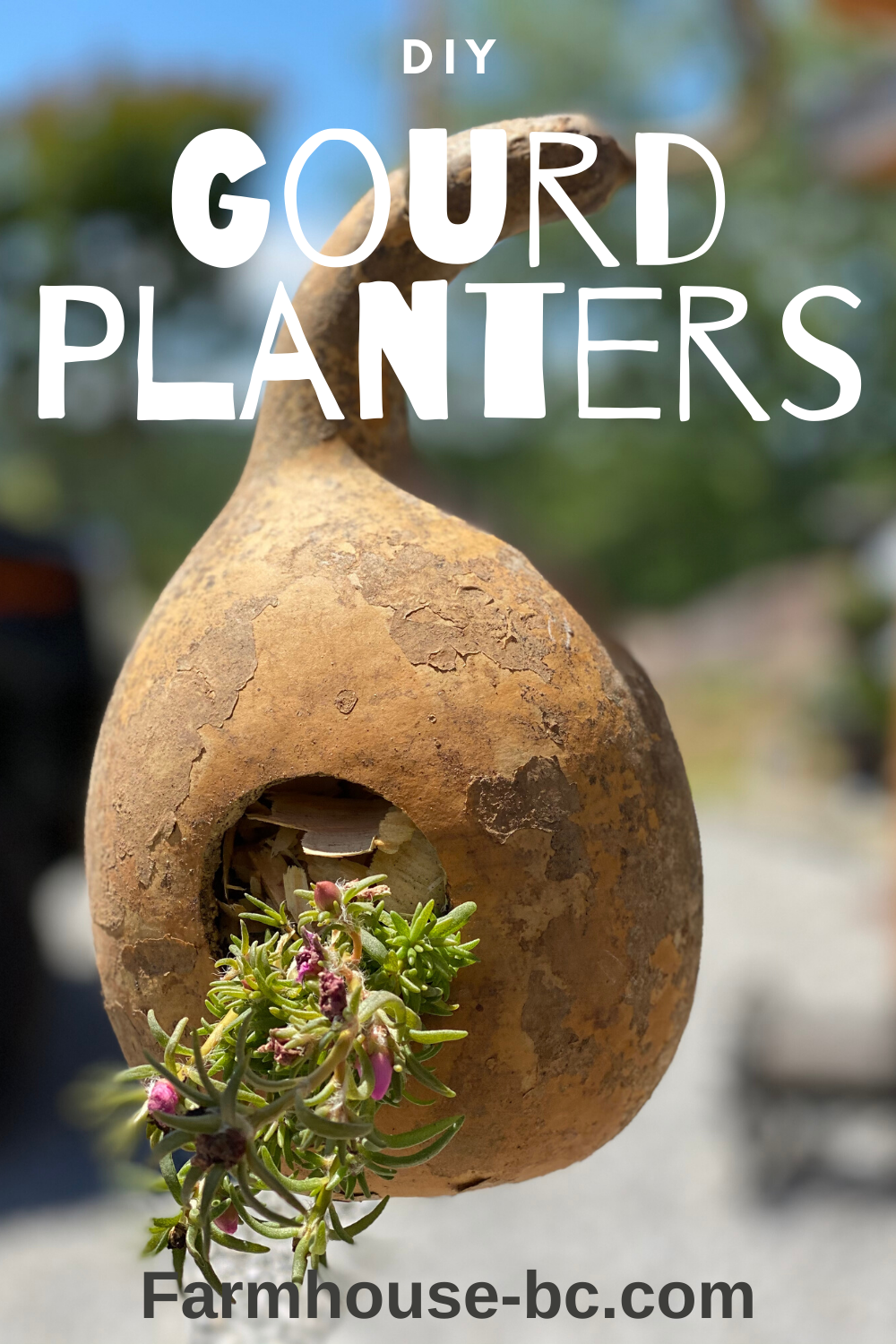
Pingback: 7 Container Gardening Tips For Beginners ⋆ Farmhouse-bc
Pingback: Squash – Planeta.com
Pingback: Attract More Butterflies In 10 Easy Tips! ⋆ Farmhouse-bc
Pingback: Vertical Gardens For Small Spaces ⋆ Farmhouse-bc
Pingback: Knowing The Difference Between Vermiculite And Perlite?
Pingback: Elderberry Vs Pokeberry-the Shocking Difference Of The 2! ⋆ Farmhouse-bc
Pingback: 5 Shocking Reasons To Buy Dollar Tree Seeds ⋆ Farmhouse-bc
You should, looks great on an arbor, instant shade to sit under.
Cannot wait to have a back yard again and grow these.
Pingback: Hanging flower basket from the Dollar Tree ⋆ Farmhouse-bc
Pingback: Gardening Tips for beginners ⋆ Farmhouse-bc
Pingback: Super easy suet bird treats - Farmhouse-bc
Pretty! This has been an incredibly wonderful article.
Many thanks for providing this information.
Pretty! This has been a really wonderful article. Many thanks for providing this information.
Pingback: 27 Most Recent How To Grow Gourds On A Trellis - www.andiraintl.com
Do you plant companion plants with the gourds or squash like nasturtiums, mint, or bee balm? They do seem to deter those bugs. I really never had bugs eat my gourd leaves. You should try it 🙂
I really love birdhouse gourds! We get terrible squash bugs. I wonder if they will survive them!
Thanks Jen 🙂
I also put strings and such in the birdhouses in the spring for the birds to make nests 🙂 double duty
It only takes me once to get a sinus infection (from chalk paint dust) to value my nose. lol Proper PPE all the way 🙂
Great post! We grew these two years ago. So fun to harvest. The mold deterred me from doing anything with them. I may try again!
I love these, Jersey! I love them as birdhouses and the planters! Goodness, just gorgeous!!
How fun! Something new to try! I love the idea of making them for birdhouses and planters!
They are fairly easy to grow. I will be adding a video to this blog post today on how I make planters from the gourds. Please come back soon and visit me.
This is my first time to try growing gourds; hope I don’t mess up to bad.
I wanted to thank you for this great read!! I definitely enjoying every little bit of it I have you bookmarked to check out new stuff you post…
I really appreciate this post. I’ve been looking everywhere for this! Thank goodness I found it on Bing. You’ve made my day! Thanks again
Pingback: Fish Emulsion Fertilizer, how to make and use! - Farmhouse Basic Collection.